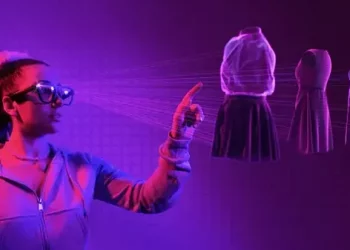The concept of the metaverse has gained significant attention in recent years, promising a virtual world where users can interact, work, and play in an immersive digital environment. At the heart of this evolving digital frontier is blockchain technology, which plays a crucial role in shaping and securing the metaverse. This article provides a comprehensive overview of the blockchain metaverse, exploring its fundamental components, how blockchain technology enhances the metaverse, and the potential implications for users and industries alike.
Defining the Metaverse
The term “metaverse” refers to a collective virtual shared space that is created by the convergence of virtually enhanced physical reality and physically persistent virtual reality. In simpler terms, it is a digital universe where users can interact with each other and digital objects in real-time. The metaverse encompasses various elements, including virtual reality (VR), augmented reality (AR), and other immersive technologies.
Key features of the metaverse include:
Immersive Environments: The metaverse provides users with an immersive experience through 3D virtual environments that can simulate real-world settings or create entirely new digital landscapes.
Interactivity: Users can interact with the digital world and other users in real-time, using avatars or digital representations of themselves.
Persistence: The metaverse continues to exist and evolve even when users are not logged in, creating a persistent virtual world that mirrors the dynamic nature of the physical world.
Interoperability: Ideally, the metaverse allows for interoperability between different virtual worlds and platforms, enabling users to transfer assets and information across various digital environments.
The Role of Blockchain Technology
Blockchain technology, often associated with cryptocurrencies like Bitcoin and Ethereum, is a decentralized ledger system that records transactions across a network of computers. This technology is fundamental to the blockchain metaverse for several reasons:
Decentralization: Blockchain operates on a decentralized network of nodes, which means that no single entity has control over the entire system. This decentralization is crucial for creating a trustless and transparent environment in the metaverse.
Security: Blockchain provides a secure method for recording transactions and managing digital assets. Each transaction is verified and recorded in a block, which is then added to the blockchain in a chronological order. This ensures the integrity and immutability of data.
Ownership and Provenance: Blockchain technology enables users to have true ownership of digital assets within the metaverse. Through non-fungible tokens (NFTs) and other blockchain-based assets, users can prove ownership and track the provenance of virtual items, such as virtual land, digital art, and in-game items.
Smart Contracts: Smart contracts are self-executing contracts with the terms of the agreement directly written into code. They automate and enforce agreements between parties within the metaverse, facilitating transactions and interactions without the need for intermediaries.
Key Components of the Blockchain Metaverse
The blockchain metaverse is composed of several key components that work together to create a seamless and functional virtual world:
Virtual Worlds: These are digital environments where users can interact, explore, and engage in various activities. Blockchain technology enables these virtual worlds to have decentralized governance and asset management.
Digital Assets: In the blockchain metaverse, digital assets include virtual land, in-game items, digital art, and other virtual objects. These assets are often represented as NFTs, which are unique and verifiable tokens stored on the blockchain.
Cryptocurrencies: Cryptocurrencies serve as the primary medium of exchange within the blockchain metaverse. They enable users to buy, sell, and trade digital assets and participate in various economic activities.
Decentralized Applications (dApps): dApps are applications built on blockchain technology that operate within the metaverse. They provide functionalities such as trading platforms, virtual marketplaces, and social interaction tools.
Governance: Blockchain-based governance models allow users to participate in decision-making processes related to the development and management of virtual worlds. This can include voting on proposals, managing resources, and shaping the future of the metaverse.
How Blockchain Enhances the Metaverse
Blockchain technology enhances the metaverse in several ways, addressing key challenges and providing benefits that contribute to a more robust and equitable virtual environment:
Trust and Transparency: Blockchain’s transparent ledger system ensures that all transactions and activities within the metaverse are recorded and verifiable. This transparency builds trust among users and reduces the risk of fraud and manipulation.
True Ownership: By utilizing NFTs and other blockchain-based assets, users have true ownership of their digital possessions. This ownership is secured by the blockchain, allowing users to buy, sell, and trade virtual items with confidence.
Interoperability: Blockchain enables interoperability between different virtual worlds and platforms. Users can transfer assets and data across various environments, creating a more connected and cohesive metaverse.
Economic Opportunities: The blockchain metaverse opens up new economic opportunities for users, including the ability to create, buy, and sell digital assets, participate in virtual economies, and earn cryptocurrency through various activities.
Decentralized Control: Blockchain technology supports decentralized governance models, allowing users to have a say in the management and development of virtual worlds. This participatory approach fosters a sense of community and shared responsibility.
Current Examples of Blockchain Metaverse Platforms
Several platforms are at the forefront of integrating blockchain technology with the metaverse, each offering unique features and opportunities:
Decentraland: Decentraland is a virtual world where users can buy, sell, and develop virtual land and assets using the MANA cryptocurrency. The platform operates on the Ethereum blockchain and features a decentralized governance model that allows users to vote on proposals and shape the future of the virtual world.
The Sandbox: The Sandbox is a blockchain-based virtual world that enables users to create, own, and monetize their virtual experiences. The platform utilizes its native SAND cryptocurrency and offers tools for users to build and manage virtual assets and experiences.
Cryptovoxels: Cryptovoxels is a virtual world built on the Ethereum blockchain that allows users to buy, sell, and build on virtual land parcels. The platform emphasizes user-generated content and provides a space for creative expression and virtual interactions.
Somnium Space: Somnium Space is a blockchain-based virtual reality world that combines social interaction, gaming, and commerce. Users can buy virtual land, build and customize their environments, and participate in various economic activities using the platform’s native token, CUBE.
Challenges and Considerations
While the blockchain metaverse offers numerous benefits, it also faces several challenges and considerations:
Scalability: The scalability of blockchain networks is a critical issue, as high transaction volumes and complex interactions can lead to congestion and increased costs. Solutions such as layer-2 scaling and sidechains are being explored to address these challenges.
Regulation: The regulatory landscape for blockchain and cryptocurrency is evolving, and legal frameworks may impact the development and operation of the blockchain metaverse. Ensuring compliance with regulatory requirements is essential for the sustainability of metaverse platforms.
User Experience: The user experience within the blockchain metaverse can be complex, particularly for those unfamiliar with blockchain technology and cryptocurrencies. Simplifying the onboarding process and providing user-friendly interfaces are important for broader adoption.
Security: Security is a paramount concern in the blockchain metaverse, as vulnerabilities and attacks can compromise user assets and data. Implementing robust security measures and best practices is essential to protect users and maintain trust in the platform.
Future Outlook
The blockchain metaverse is an evolving space with significant potential for innovation and growth. As technology continues to advance, we can expect to see further developments in the following areas:
Integration of Emerging Technologies: The integration of technologies such as artificial intelligence (AI), augmented reality (AR), and virtual reality (VR) will enhance the capabilities and experiences within the blockchain metaverse, creating more immersive and interactive environments.
Expansion of Use Cases: The blockchain metaverse will likely expand beyond gaming and virtual worlds to include applications in areas such as education, healthcare, and remote work. These new use cases will contribute to the overall growth and adoption of the metaverse.
Enhanced Interoperability: Improved interoperability between different metaverse platforms and blockchain networks will create a more connected and seamless virtual experience for users, allowing for the transfer of assets and data across various environments.
Increased Regulation and Standards: As the blockchain metaverse matures, regulatory frameworks and industry standards will likely evolve to address legal and ethical considerations. These developments will contribute to a more secure and well-regulated metaverse ecosystem.
See also: What Is Defining Feature Of The Metaverse
Conclusion
The blockchain metaverse represents a groundbreaking convergence of blockchain technology and immersive virtual environments. By leveraging the decentralized, secure, and transparent nature of blockchain, the metaverse offers new opportunities for ownership, economic activity, and community engagement.
As the metaverse continues to develop, it will shape the future of digital interactions and experiences, providing a dynamic and evolving space for users and industries alike. Understanding the intersection of blockchain technology and the metaverse is essential for grasping the full potential of this transformative digital frontier.
Related topics:

















